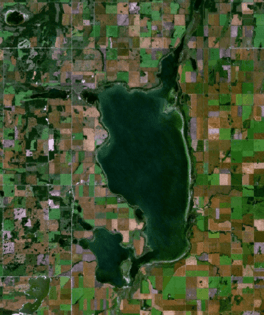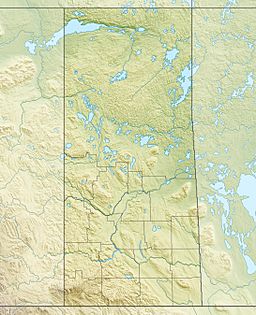Lenore Lake facts for kids
Quick facts for kids Lenore Lake |
|
|---|---|

Lenore Lake as seen from space.
|
|
| Location | Lenore Lake No. 399 / Three Lakes No. 400, Saskatchewan |
| Coordinates | 52°30′N 104°59′W / 52.500°N 104.983°W |
| Type | Freshwater |
| Basin countries | Canada |
Lenore Lake is a special lake in Saskatchewan, Canada. It's known for being "partly saline," which means its water is a bit salty, but not as salty as the ocean. This unique lake is part of a bigger area called the Lenore Lake Basin.
This basin is home to several other lakes. Some are salty, like Basin, Middle, Frog, Ranch, Murphy, Flat, Mantrap, Houghton, Deadmoose, and Waldsea. But there are also freshwater lakes, like St. Brieux Lake and Burton Lake. The cool thing about this basin is that it has no natural way for water to flow out. This means water stays within the basin, which can cause changes in lake levels over time.
Lenore Lake is also a very important place for birds. Back in 1925, it was named a migratory bird sanctuary. This means it's a safe home for many birds that travel long distances. The lake also supports different kinds of fish, including walleye, whitefish, perch, and northern pike.
Protecting Lenore Lake
In recent years, the amount of water in the Lenore Lake Basin has grown a lot. This has caused the water levels to reach their highest points ever. One nearby lake, Houghton Lake, is very salty. Its water started flowing into Lenore Lake.
To keep the salty water from Houghton Lake from harming the fish in Lenore Lake, an important decision was made. On May 10, 2010, the Canadian government's Environment Canada department ordered a special pipe, called a culvert, to be closed permanently. This culvert was letting the salty water pass between the two lakes. Closing it helped protect the fish and their home in Lenore Lake.
Fish and Water Quality
In 2009, the government of Saskatchewan gave advice about eating fish from Lenore Lake. This advice was for walleye and northern pike. It was because a small amount of mercury was found in some of the fish.
These guidelines help people know how much fish is safe to eat. It's a way to make sure everyone stays healthy while enjoying fish from the lake. Scientists continue to monitor the lake's water and fish to keep them safe.


